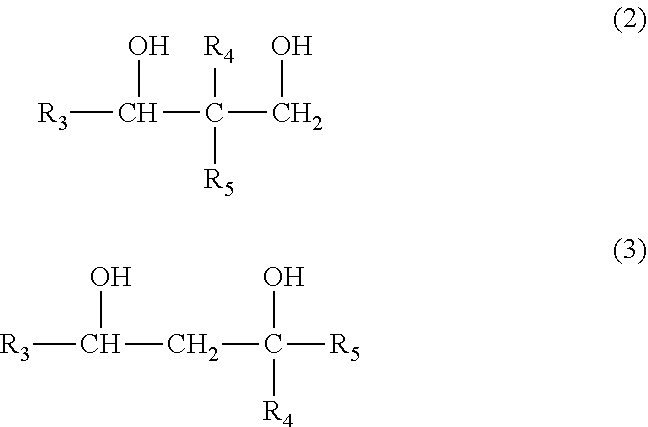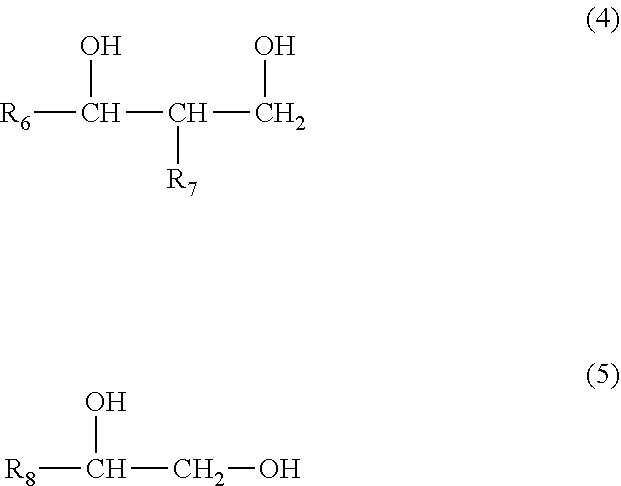Aqueous silicone polymer compositions
a silicone polymer and composition technology, applied in the field of aqueous silicone polymer compositions, can solve the problems of limited use, inadequate antimicrobial effectiveness of compositions containing silicone polymers, and known combinations of antimicrobial components that do not provide adequate microbiological protection, so as to reduce friction between hairs, and improve the effect of antimicrobial
- Summary
- Abstract
- Description
- Claims
- Application Information
AI Technical Summary
Benefits of technology
Problems solved by technology
Method used
Image
Examples
example 1
[0121]An aqueous microemulsion comprising 20% of an amino group-modified silicone with aminoethylaminopropyl pendant groups and an amino content of 0.77 mmol NH2 / g and 19.3% of a mixture of an alkylpolyglycoside and cocosamidopropyl betaine surfactants, was prepared by first mixing 50 parts of the aminosilicone with
2.25 parts (0.9%) of 2-phenoxyethanol (component a)),
3.75 parts (1.5%) of 2-butyl-2-ethyl-1,3-propanediol (component b)), and
1.5 parts (0.6%) ethylhexyl glycerin (component c)),
then adding this mixture to a solution of the 87.5 parts Plantacare 2000 UP (a 50% aqueous solution of C8-C16 alkylpolyglycosides sold by the BASF SE, Ludwigshafen, Germany) and 15.0 parts of Genagen CAB 818 (a 30% aqueous solution of cocosalkylamidopropylbetaine sold by the Clariant GmbH, Frankfurt am Main, Germany) in 84.23 parts water and adjusting the pH with 3.0 parts L-arginine and 2.77 parts acetic acid, the remainder being water, in accordance with WO2011042409. The final microemulsion had ...
example 2
[0125]A microemulsion comprising 20% of a silicone polymer comprising at least one quaternary ammonium group, Silicone Quaternium-18, and 10% of a mixture of nonionic surfactants was prepared by first mixing 20 parts of the silicone quat polymer as a microemulsion with 10 parts of the non-ionic surfactants and then adding 70 parts of water and mixed at ambient temperature until clear. The final unpreserved emulsion had a viscosity of 17.8 mPa*s at 25° C., a solids content of 30.3%, a pH value of 8.0 and a color according to Hazen of 71.
[0126]To 95.7 parts of this microemulsion were added
3.3 parts (3.3%) 2-phenoxyethanol (component a)),
1.0 part (1.0%) 2-butyl-2-ethyl-1,3-propanediol (component b))
and mixed at ambient temperature until clear. The microemulsion exhibited moderate microbiological growth upon incubation at 25+ / −2° C. for 7 days, but no microbiological growth 14 days, after inoculation with 1.0% of a suspension of microorganisms with a titer of 105 KBE / ml microorganisms, ...
example 3
[0129]To 95.7 parts of the microemulsion in Example 2 were instead added
1.0 part (1.0%) 3-phenyl-1-propanol (component a)),
3.3 parts (3.3%) 2-butyl-2-ethyl-1,3-propanediol (component b))
and mixed at ambient temperature until clear. The microemulsion exhibited moderate microbiological growth upon incubation at 25+ / −2° C. for 7 days, but no microbiological growth 14 and 28 days, after inoculation with 1.0% of the suspension of microorganisms used in Example 2.
PUM
 Login to View More
Login to View More Abstract
Description
Claims
Application Information
 Login to View More
Login to View More - R&D
- Intellectual Property
- Life Sciences
- Materials
- Tech Scout
- Unparalleled Data Quality
- Higher Quality Content
- 60% Fewer Hallucinations
Browse by: Latest US Patents, China's latest patents, Technical Efficacy Thesaurus, Application Domain, Technology Topic, Popular Technical Reports.
© 2025 PatSnap. All rights reserved.Legal|Privacy policy|Modern Slavery Act Transparency Statement|Sitemap|About US| Contact US: help@patsnap.com



